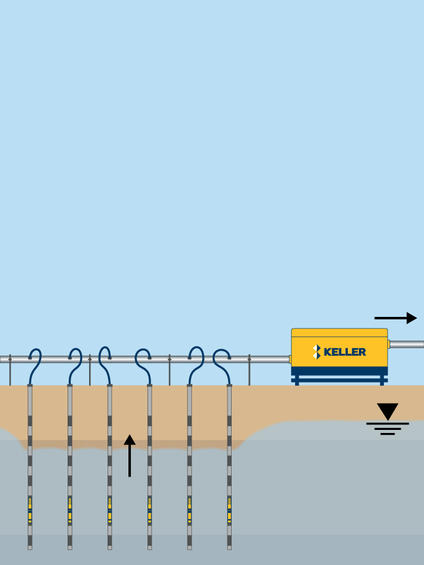Construction dewatering, the temporary lowering of the groundwater, has been practiced by Keller for more than 90 years, and we are recognized as the industry's preeminent dewatering contractor and an innovator in the field.

Common uses
Process
Under some circumstances, artificial recharge can be used to minimize the potential side effects of excessive groundwater lowering during construction.
Groundwater control can also be provided by installing subsurface barrier walls or ground modification methods. In addition to construction applications, groundwater control methods can be used for environmental containment and structural seepage control or stabilization of waste products such as coal combustion residuals.
Specialist contacts
Keller provides dewatering services nationwide, through dedicated regional offices.
- Andrew Buttitta, P.E. | Area Manager, Kiowa, CO | 201-230-5459
- Donald Young Sr. | Area Manager, Corona, CA | 951-258-9422
- Mark Farkas | Project Manager, Walnut Creek, CA | 925-825-5056
- George King, Jr. | Area Manager, Odenton, MD | 443-951-4138
- Joshua Kaiser, P.E. | Senior Engineer, Rockaway, NJ | 973-796-8494
- Matthew DeGregoris | Area Manager, Rockaway, NJ | 973-400-3610
- Greg Landry, P.E., LEED AP ® | Chief Dewatering Engineer, Rockaway, NJ | 973-400-3621
- Matthew Zabawa, G.I. | Design Engineer, Omaha, NE | 973-713-8192
Primary dewatering systems
Since its first deep well system was installed in the mid-1950s, Keller has successfully engineered numerous dewatering projects to allow excavation in the dry, including the largest single dewatering effort ever accomplished in the United States for the construction of Lock & Dam 26 across the Mississippi River. This depth of experience and engineering expertise is unmatched by any other construction dewatering contractor.
A deep well is a dewatering device equipped with a submersible pump. Deep wells can vary from 3 to over 24 inches in diameter, can be installed from 20 feet to hundreds of feet deep, and pump from a fraction to thousands of gallons per minute. Deep wells are best suited where permeable soil extends well below the bottom of the excavation. Deep wells are equipped with individual submersible pumps. Unlike well points, deep wells are not limited by suction and can be installed from 20 feet to hundreds of feet deep. Since each deep well involves a higher unit cost than other pre-drainage systems, deep wells are best suited to homogeneous aquifers extending well below the excavation's bottom.
Deep well dewatering with well points is also proving successful in stabilizing wet fly ash and bottom ash ponds at existing or former coal-fired generating stations for fast, safe, and effective clean closure in compliance with EPA regulations.
Deep wells can be constructed by several methods, including jetting with pressurized water, direct rotary drilling, bucket drilling, and duplex drilling. Keller determines the best installation method based on site geology and other project specifics.
The wellpoint system is the oldest method of predrainage. Over the last 90 years, Keller has completed numerous wellpoint dewatering projects and is recognized as North America's leading wellpoint contractor.
The basic wellpoint system consists of well points, header piping, and a centrally located pumping station serving the whole system. Wellpoint systems are very cost-effective where close spacing is required. However, as a vacuum-type system, their effectiveness is limited by depth, and available suction lift to 15-20 ft.
Well points are typically installed around the perimeter of the excavation by self-jetting methods, with a hole puncher used to penetrate coarse gravels, cobbles, and boulders. In difficult ground, penetration can be facilitated by various drilling methods.
An ejector system is a hybrid system between well points and deep wells. Ejectors are typically used where the groundwater must be lowered more than 15 feet and the soil is of low hydraulic conductivity, so vacuum application is beneficial to improve soil drainage.
Unlike deep wells, which are equipped with individual submersible pumps, an ejector system (also called an eductor system) allows multiple wells to be powered by a single pumping station. Single-pipe and two-pipe ejector systems are available. The single-pipe system is typically used when the well casing is less than three inches in diameter, while the two-pipe system requires a minimum 4-inch well screen and casing. The two-pipe ejector is the simplest to install and can be easily removed for maintenance.
However, ejectors are inherently inefficient, and their application requires accurate knowledge of site conditions and practical restraints.
Since they are not limited to suction lift and have a lower unit cost than deep wells, ejectors are well suited for deep excavations in stratified soils where close spacing is required. Single-pipe ejectors are installed using methods similar to well points, while two-pipe ejectors are typically installed by mud rotary drilling techniques.